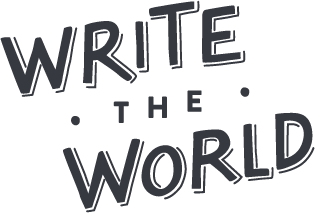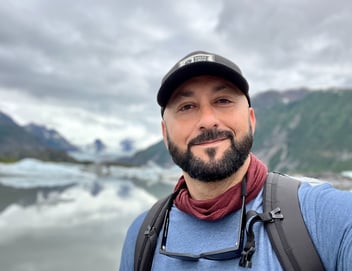For most readers, poetry is the genre of literature that holds an air of mystery over us. Poems are unlike other literary arts in that they aren’t made up of sentences, paragraphs, passages, and chapters. They are often small, strange shapes. They don’t have the usual literary tropes of characters, plot, and symbolism; they more intimately play with time and consciousness. They are shaped by lines—sometimes jagged, sometimes uniform. Sometimes they are made of couplets, sometimes stanzas. Sometimes poems rhyme, sometimes they don’t. This diversity of style can seem daunting. This month—national poetry month—we’ll be working to shift the paradigm of reading poems from daunting to exciting. To do that, we will begin learning new terms to help us articulate what we experience within the lines of a poem.

A POET’S GLOSSARY
Learning to read poetry is like learning to read sheet music or a new language. Though made of words, a poem does not look, sound, or feel like the prose we are used to reading. While we are used to thinking of language units as sentences and paragraphs, we need to adjust our eyes and ears to lines and stanzas. These new terms and forms have their own unique meanings. They signal complex structures and mores in the world of a poem. While we are used to being afraid of poetry for these exacting and seemingly exclusive properties, by reframing them as mysteries we can begin to read like a poet.
A poet’s approach to language is different than other genres of writing. By organizing language into patterns, lines, forms, and schemes, words begin to work like music—like an arrangement. Even considering the line as a unit shows a reader that each word and its order will hold a lot of emotional and narrative weight. A rhyme scheme can elevate language to the emotional and sonic transcendence of music. As we begin to look at poems, it’s important to approach these strange and loud properties with curiosity. A poem is a map. Within it, a reader can seek all kinds of linguistic, narrative, and emotional treasures. To help us reach such transcendence, we can study the vocabulary of poetry. As we learn in A Poet’s Glossary by Edward Hirsch, steeping ourselves in poetry’s language—the name of forms, meters, rhyme schemes, etc.—the world of poetry becomes intimate and personal for the reader. Some terms are familiar and easy to understand. Others are archaic and hold a lot more history than we might guess. But in each word, Hirsch shows us how we can use the tools of poetry to read poems with confidence and curiosity.
“I’ve learned a tremendous amount in researching this book over the past fifteen years. As I’ve worked, I’ve often found myself transported to different time periods and countries, placing myself here and there, wondering what it would have been like to be a poet in the heady days of eighth-century China, or twelfth-century Provence, or thirteenth-century Florence, or fourteenth-century Andalusia, or fifteenth-century Wales, or seventeenth-century Japan, or early nineteenth-century England, or late-nineteenth century Ireland, or early twentieth-century Russia…I move freely among the bards, scops, and griots, the tribal singers, the poets of courtly love who sang for their mistresses, the court poets who wrote for their supper, the traveling minstrels, the revolutionaries, the flaneurs, the witnesses. I’ve encountered a series of recurring questions and debates about style and language, like the unresolved argument about the plain and baroque style, or about the role of poetry in culture and society. There has been an ongoing quarrel, played out in many different countries, between tradition and innovation, the local and the international, the home-grown and the cosmopolitan. What language does one use, what forms does one employ? To whom is the poet responsible, and to what? Poetry, too, takes part in conversations about identity and nationalism…
The devices work the magic in poetry, and a glossary gives names to those devices. It unpacks them. I believe its purpose is to deepen the reader’s initiation into the mysteries. Here, then, is a repertoire of poetic secrets, a vocabulary, some of it ancient, which proposes a greater pleasure in the text, deeper levels of enchantment.”
(vi)
Hirsch then goes on to give us a glossary. An alphabetized book of new words to help us enter poems and understand how and why they take on certain shapes, certain stakes based on the traditions of a given time and place. While some of these words are, as he says, archaic—they describe poems or movements in poetry that might not apply to every poem—it is easy for us to keep this book at the ready and use it to look into the poems we want to understand more deeply.
A Poet’s Glossary by Edward Hirsch: An abecedarian is a poem whose lines are alphabetized. Ars poetica is a metacognitive poem—a poem about poem making. An aubade is a poem meant for dawn or early morning. And those are just a few examples from the early pages of this glossary. Hirsch collects hundreds of words used from different countries and times from the complex world of poetry. Whether you’re a language fanatic ready to devour this book cover to cover, or a new reader of poetry who wants to use it to deepen specific reading experiences, Hirsch’s collection of words will teach any lover of poetry how to deepen their curiosity around poems.

Poetic Language Exercises
“One Art” by Elizabeth Bishop
- Using Hirsch’s glossary, name the form of this poem. What are you drawn to in the form? What do you find yourself resisting in the form?
- In “One Art”, Bishop’s speaker says that “the art of losing isn’t hard to master”. What poetic tools does Bishop use to battle loss?
- What things have you lost? What things do you wish to keep? How might a form help you organize these objects and ideas into a poem?
- What other forms help the speaker from “losing” ideas and language? Try one of your own!
“The Road Not Taken” by Robert Frost
- Many readers misinterpret Frost’s poem as an inspiration to be different—to “take the [road] less traveled by”. While this might be good life advice, it’s not what the speaker in the poem struggles with. What is it that triggers the speaker to have these thoughts?
- Using Hirsch’s glossary, go through the poem line by line and name some of the poetic tools Frost employs in the poem.
- What is the relationship between the poem’s form and the central questions that haunt the speaker?
- What are the moments in your own life where your life could have taken a different direction? Write a poem about one of these moments.
“Sonnet 18” by William Shakespeare
- Using Hirsch’s glossary, point to the elements of the sonnet in this poem. Label the rhyme scheme, find the turn, and if you want a real challenge, try to work the rules of iambic pentameter.
- This sonnet is a love poem. How do Shakespeare’s poetic tools mimic love itself?
- What does “this” refer to in the final couplet?
- What is ars poetica? How does Shakespeare employ ars poetica in this sonnet?
“We Real Cool” by Gwendolyn Brooks
- Using Hirsch’s glossary, identify the elements of free verse poetry used in this poem. Then go through and find patterns. Use Hirsch’s glossary to help you name these poetic tools.
- Who is the speaker? Why does “we” appear at the end of each line? How might you describe this technique using Hirsch’s glossary?
- How does the location of the poem influence your reading of the poem? Why is it a necessary detail to the lyric that follows?
- How does Brooks use sound in this poem? What is the relationship between sound and the passing of time in this poem

BONUS: To get even more engaged with “We Real Cool”, watch the short film of the same name about Gwendolyn Brooks and her famous poem. This film was a collaboration between Eve Ewing, Nate Marshall, and Manual Cinema.
- How does the film help you understand this poem more deeply? What new information do you learn from hearing Brooks speak? What new information do you learn from the visual impact of the film?
- What is the role of witness in writing this poem? What is the role of being a witness in order to be a poet? In order to be a decent citizen?
- How does this poem model the role of community in understanding and making art?
So dear writers, as you read and write poems this month and for the months to come, keep your own glossary of words. Words you learn from Hirsch, words you make up yourself, to describe all that you see, hear, and feel in your encounters with poetry.
About Lisa
Lisa Hiton is an editorial associate at Write the World. She writes two series on our blog: The Write Place where she comments on life as a writer, and Reading like a Writer where she recommends books about writing in different genres. She’s also the interviews editor of Cosmonauts Avenue and the poetry editor of the Adroit Journal.





